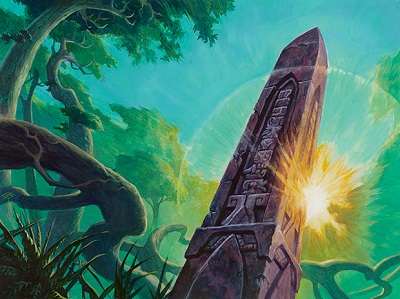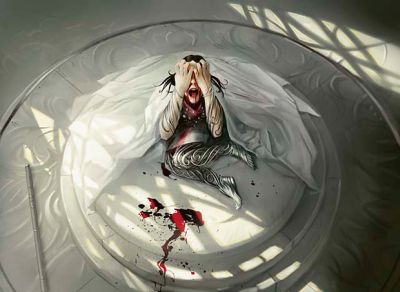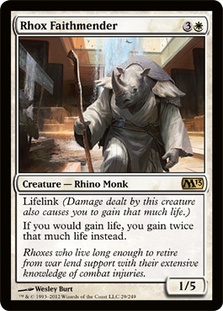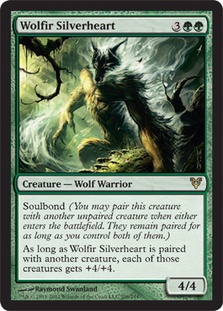Welcome back, Untappers!

Today we venture into the jungles, valleys, and open expanses of Naya!

Well, figuratively, anyway.
This past weekend, I played in the SCG Classic Series in Louisville, Kentucky—my hometown! It was a real treat to get a large-scale tournament literally two miles from my house, and I was excited to play a Spike-y aggro deck I’d been tuning carefully for the big day.
Let’s get right into the list!
Creatures (31)
- 4 Mogg Flunkies
- 2 Yeva, Nature's Herald
- 4 Flinthoof Boar
- 4 Loxodon Smiter
- 4 Burning-Tree Emissary
- 4 Experiment One
- 4 Ghor-Clan Rampager
- 1 Gyre Sage
- 4 Boros Reckoner
Planeswalkers (3)
Lands (22)
Spells (4)

It’s pretty clear that this deck has one purpose in life: smash—and smash hard. This is probably the closest thing to a Spike deck I’ve ever made myself, but it’s still far from perfect. The game plan here is pretty simple: get an Experiment rolling on turn 1 followed by Burning-Tree Emissary and/or Mogg Flunkies and start beating down, using the top end to apply deeper pressure and to create a strong board presence into the late turns of the game.
It was aimed to be a consistent turn 4 killer with enough juice to keep the threats coming turn after turn. In playtesting, it did just that; it was excellent at punishing poor keeps and could easily capitalize on a stutter. I loved Domri Rade as a way to close out games with Boros Reckoner fighting some big thing on my side or theirs, and with 31 creatures, his +1 would more often draw you a card than not.
The inspiration for the deck came from successful Jund builds I’d read about that used Experiment One to great effect. I decided to go in a Naya direction to get a stronger sideboard and so I could play Loxodon Smiter and Boros Reckoner. Loxodon Smiter is a house in a format of 3/3s, and his additional abilities only add to his power. I hadn’t seen a Naya deck use Experiment One, and it seemed reasonable with every other creature in the deck evolving it. With that base, I added strong creatures picked more for their stats than their utility.
White provided nearly every card in the sideboard. Four Thalias could keep midrange and U/W/x builds in an awkward position and provide me the time I needed to add more brawlers to the board and delay their Wraths and removal. Boros Charm was intended as a planeswalker smasher (most planeswalkers have four loyalty counters after using their most common ability) and a Wrath stopper. The double strike could only be relevant in niche situations, perhaps after a Ghor-Clan Rampager bloodrush. Nearheath Pilgrim was in here for the creature mirror, allowing me to pull ahead on the back of my highly efficient creatures. Rest in Peace, the least synergetic card in the board, is just too good not to play, and it’s the best answer for any shenanigans from the graveyard.
Selesnya Charm is actually here for one mode: the exile one. Sure, the other ones could be relevant, but more than anything else it’s meant to deal with creatures that are out of range of my burn. Thundermaw Hellkite, Thragtusk, a lofty Olivia Voldaren, Angel of Serenity or even a Rancored or Wolf Runned target could all be sent packing for GW. I found this deck had difficulty dealing with big creature threats, and this Charm was our ticket in.
My singletons, Sigarda, Host of Herons and Witchbane Orb, were last minute additions. Sigarda is really hard for non-Wrath decks to answer, and she provides an airborne win condition or a sturdy flying wall. Also, casting her at instant speed with Yeva, Nature’s Herald feels super. Restoration Angel? Hah! Finally, the Orb was here for other decks that I’d have trouble interacting with, such as Drownyard Esper, B/R Control, and Bonfire decks.
I created this deck for one task: to be a purpose-built response to my perceived prevalence of aggro decks in Standard. Human decks would have trouble getting past Loxodon Smiter and Boros Reckoner, and the tight construction would ensure consistent pressure in aggressive duels and in more defensive matchups. I thought about using a fun G/W/B deck I’d had some FNM success with over the last week or so, but I eventually ruled it out as too inconsistent, so I settled on Naya. More on that deck later…
After carefully considering every card in the 75, there was nothing left to do but sleeve it up and head up the street to the Classic.
Saturday morning was a cool, moist affair with temperatures hovering around freezing as the sun rose over the Ohio River. I rose early, lugged my game-day gear (a backpack filled with binders, my EDH decks for downtime, and my freshly updated Modern Peasant cube) to my Volkswagen, and tootled downtown. I was among the first couple dozen to arrive, and I settled down in the modest game hall with some pals for some trading and playtesting. I battled against The Aristocrats and U/W/R Reckoner, each with firm success.
Finally, it was time to start the tournament, and I was excited to beat face! Nearly three hundred people showed up, which I believe is the largest Classic Series event ever!
After beating my round 1 opponent, who was playing BUG Zombies, I was exceptionally confident. Shortly afterward, however, I proceeded to lose a tidy 0-2 to a modified DeTora Wolf Run Bant list and a 1-2 to Jund Aggro. Now forced to decide whether I’d spend the next six rounds in a tournament where I could not drop a match in order to cash at all, I dropped.

I didn’t make any marked play mistakes from what I could tell, but the decks I played and the pilots behind them were just better than me. The Bant deck ran circles around me and scoffed at my big beaters with Thragtusk and Sphinx’s Revelation. Sure, I had a couple sour mulligans in round 3, but the Jund Aggro list was just a better deck packed with better creatures, more reach, and what I consider to be the best targeted removal suite in any aggro deck right now.
I wasn’t angry, but I was disappointed. After just three rounds, both a defensive and an aggressive deck had beaten me handily, and I’d played my best. Regardless of the result, though, I had fun doing it. Each of my opponents was kind, considerate, and friendly. Furthermore, the deck I’d brought wasn’t a poor deck; in fact, it’s the most consistent deck I’ve ever played. That’s what all those four-ofs will do for you. The deck did what it was supposed to, but it wasn’t very good at much else. In each lost match, there were specific cards that proved immensely difficult to defuse. From the Bant matchup, it was this.
I literally could not beat this card. If you are playing a white control deck with a way to protect this card, I can guarantee you will win a lot of aggro matchups when you resolve him. Play him. Black has plenty of answers for the Rhino; Naya has zero. Secondly, I had a problem with our friendly bonding Wolf.
The Jund matchup brought him to light, and resolving him and buddying him up with a Thundermaw Hellkite was nearly unbeatable. Except for Selesnya Charm (which I cast that game on the Hellkite and still lost to a Falkenrath Aristocrat), my removal was completely damaged based, and if a problem creature arose, my assault ground to a halt. Rhymed it.
Although this deck was consistent and powerful, it was dead to a lot of strategies even post-sideboard. I’m pretty sure more playtesting could have eliminated a lot of these problems. A set of Deadbridge Goliath got cut, which would certainly have been helpful, and even a bit of flying hate could have helped me have a bit more success. As stated earlier, the deck didn’t have a lot of options, and I love options.
I won’t give up on this deck, and I highly recommend it for aggro-heavy metagames near you. From my experience, Louisville is a heavily control-oriented metagame, and I thought this deck could get ’em dead before they could get off the ground. I was pretty wrong about that, and despite repetitive, redundant draws and a no-nonsense game plan, we couldn’t get there.
I spent the rest of the day visiting with people at the event; I knew a large number of them from shops around town. I even squeezed a couple drafts in with moderate success. They made me realize that Gatecrash is a masterfully crafted Draft set and that I am all about the Simic plan. In retrospect, I wish I had stayed in for a couple more rounds to get a better feel of the room’s metagame. I recommend you do the same at your next big tourney; give it a couple rounds even if you’re out of prize range. There’s no pressure, and you can still play high-level Magic!
I want to make a final note on deckbuilding for this event. In my opinion, there are three deckbuilding questions you should ask yourself when building anything from a fun brew to a serious tournament contender.
1. Does the deck have a clear path to victory?
2. Does the deck provide answers to confound your opponent’s path to victory?
3. Can the deck do both of these consistently and repeatedly?
This deck did well on #1 and #3, but it failed #2. It could not interact effectively, which I believe was ultimately its major weakness. Maybe you guys have already seen or tried a deck like this one and saw the potential for some better answers. Does the deck look strong to you? Where would you make changes? Based on your local metagame, would this deck be a good choice? Let me know in the comments below!
There isn’t a big Standard tournament around me for the next few weeks, but that’s ok! Now I can relax, undo my tournament tie, and focus on some of the more fun brews that I’ve had to shelve over the past month or so. I’ve got several that you’re going to love, so make sure to drop by next week! Until then, don’t forget to untap!
– Matt
untaptargetplayer.blogspot.com
CaptainShapiro on Magic Online


